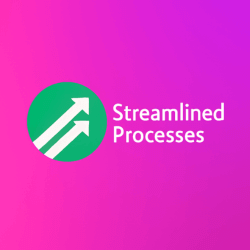For B2B Marketing Automation, see our main page here.
What Is B2B Marketing Automation?
B2B Marketing Automation refers to the use of software to automate marketing tasks in business-to-business (B2B) environments. These tools streamline processes like email marketing, lead nurturing, performance tracking, and customer segmentation. As a result, companies can deliver the right message at the right time with minimal manual effort.
Unlike B2C strategies, B2B deals with complex sales cycles and multiple decision-makers. Therefore, automation helps marketers stay consistent and relevant across touchpoints. It’s not just a timesaver; it’s a method to improve ROI and build lasting relationships with target accounts.
Why Automation Matters in B2B
Marketing teams are stretched thin. They need to manage campaigns, analyze data, and generate leads—all while driving growth. In B2B, this challenge grows due to high-ticket sales, longer cycles, and research-driven buyers. Automation cuts through the clutter and brings focus to strategy execution.
For example, an enterprise software company can use automation to score leads based on engagement and send customized emails to move prospects down the funnel. Sales teams then spend time only on qualified opportunities, speeding up the close rate by over 30%, according to HubSpot.
Key Features of Effective B2B Marketing Automation Tools
- Lead scoring and nurturing
- Email and campaign automation
- CRM integration
- Behavioral tracking
- Advanced segmentation
- Performance analytics and reporting
Most importantly, these features must integrate seamlessly with existing systems. Otherwise, companies risk silos that slow down operations. Therefore, evaluating compatibility is critical during the selection process.
Choosing the Right Tool for B2B Marketing Automation
Different companies have different goals. A startup may prioritize lead generation, while a mid-market firm might focus on lead nurturing and reporting. There’s no one-size-fits-all platform, but a few stand out for B2B use cases:
- HubSpot: Best for inbound-driven teams wanting robust CRM functionality.
- Marketo: Ideal for larger organizations needing advanced segmentation and scoring tools.
- Pardot (by Salesforce): Seamless for firms already using Salesforce for CRM.
Before committing, consider a demo and trial period. Test how new tools fit your workflows. Likewise, measure ease of use, data migration capability, and support quality.
Practical Use Cases of B2B Marketing Automation
To clarify how automation works, let’s explore some examples:
- Onboarding: Automatically send a series of helpful emails to new contacts.
- Webinar Follow-up: Trigger a content offer after someone attends an event.
- Lead Nurturing: Use behavior-based emails to guide a buyer through complex product decisions.
- Sales Alerts: Notify reps when a lead reaches a specific engagement score.
These sequences reduce manual follow-ups and ensure consistent outreach. Consequently, teams can scale personalized engagement without burning out.
Biggest Challenges in Implementing Automation
Automation can’t solve all problems—and poor implementation can create new ones. Common challenges include:
- Lack of quality data
- Inadequate staff training
- Insufficient strategy before setup
- Overdependence on automation without human review
To overcome these issues, companies should invest in team education and start small. For instance, automate a single nurture sequence before rolling out company-wide campaigns.
B2B Industry Trends Influencing Automation
As technology evolves, so do the expectations of B2B buyers. They want timely, helpful content—not generic messages. Therefore, automation strategies must adapt. Here are trends shaping the future:
- AI-Powered Personalization: Machine learning tailors messages using deep behavior insights.
- Account-Based Marketing (ABM): Targeting specific companies instead of large segments.
- Omnichannel Integration: Coordinating campaigns across email, LinkedIn, SMS, and CRM in unison.
- Predictive Lead Scoring: Using AI to assess deal readiness more accurately than static scoring rules.
In the same vein, buyers expect their vendor interactions to be just as personalized as their B2C experiences. Automation can bridge that gap when used thoughtfully.
Measuring ROI for B2B Marketing Automation
To prove value, marketers must connect automation back to revenue. Key metrics to monitor include:
- Lead-to-opportunity conversion rate
- Email engagement rates
- Influenced revenue from automation campaigns
- Customer acquisition cost (CAC)
- Average sales cycle length
For example, if your automation system increases MQL (Marketing Qualified Lead) conversion by 25%, calculate how much new revenue results over time. Use dashboards to monitor trends monthly and revise automation workflows based on real performance data.
FAQ: B2B Marketing Automation Essentials
What’s the difference between B2B and B2C marketing automation?
B2B targets businesses with multiple stakeholders and longer sales cycles. Meanwhile, B2C focuses on individual buyers and faster decision-making. Therefore, B2B automation emphasizes lead nurturing, scoring, and account-based strategies.
How long does it take to see results from automation?
Typically, results appear within 3 to 6 months. This depends on your content quality, strategy, and follow-through. However, some companies see early wins if they sync sales and marketing efforts well.
Can small B2B firms benefit from automation?
Absolutely. Many small firms automate lead intake or email campaigns to save time. Even simple tools create outsized impact when used strategically.
Do I still need human input if I use automation?
Yes. Automation handles repetitive work, but humans provide creativity, empathy, and judgment. A well-balanced strategy uses both to maximize outcomes.
How do I avoid overwhelming prospects with too many emails?
Set frequency caps and use behavioral triggers to send only relevant messages. Always include unsubscribe options and monitor engagement closely.
In Conclusion: The Future of Smart B2B Execution
In short, B2B Marketing Automation empowers teams to do more with less. It brings structure to outreach, adds consistency, and supports better alignment with sales. With clear goals, the right tools, and actionable workflows, you can improve both revenue and customer satisfaction.
This article was created with the assistance of AI tools and reviewed by our team at Streamlined Processes LLC to ensure accuracy and relevance.
Follow us on Facebook here.

